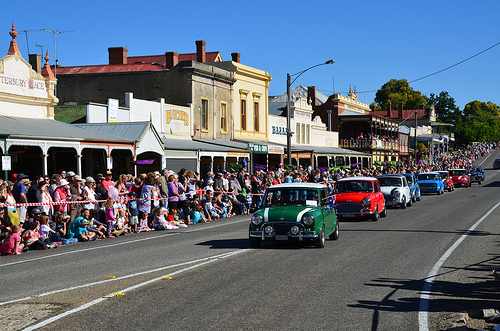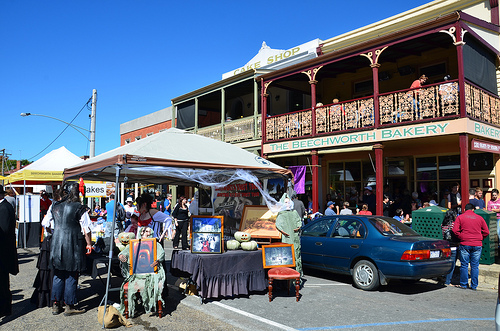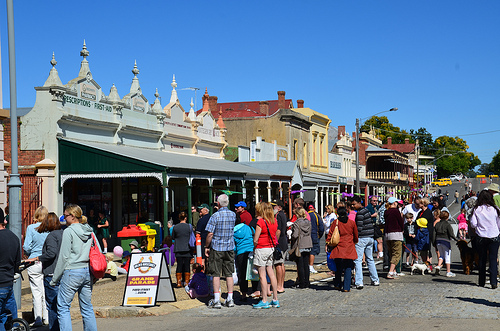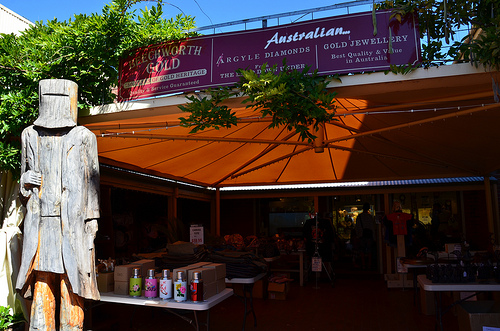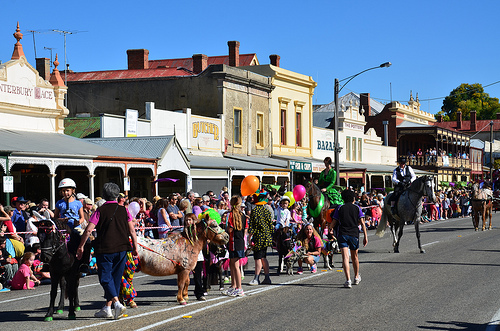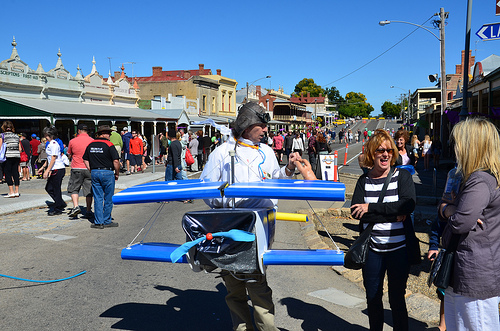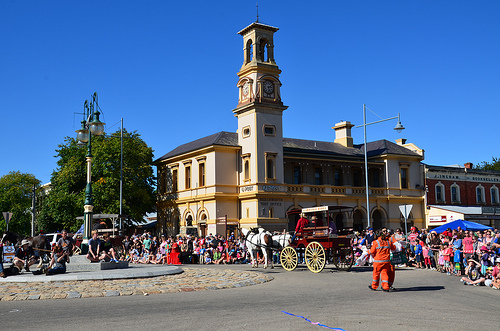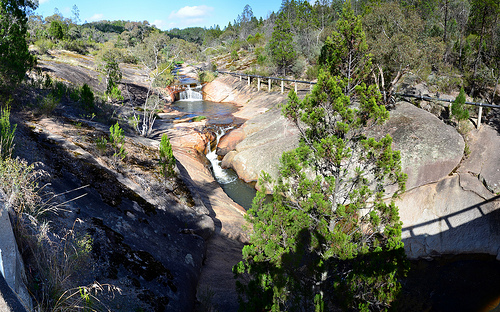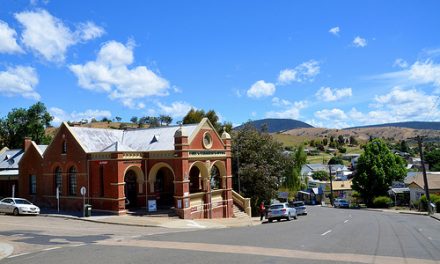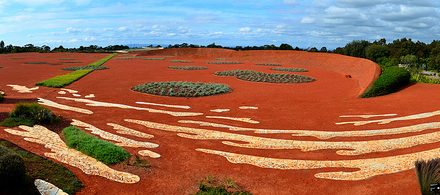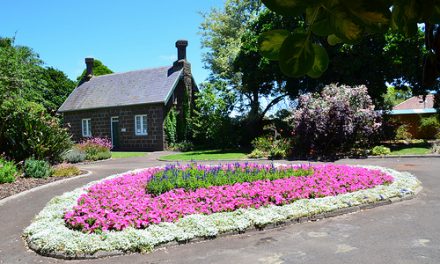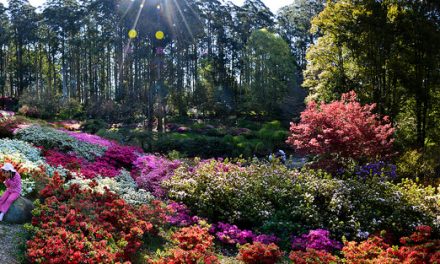In May 1852, Lieutenant-Governor GJ La Trobe named the area Mayday Hills which was originally used for grazing by the pastoralist David Reid. In January 1852, one of Reid’s former shepherd named Meldrun discovered gold near the present site of the Newtown Bridge while searching for a lost sheep along Spring Creek. By November 1852, some 1500 people were panning for gold in the district. By January 1853, that number multiplied to about 8000. In the 14 years from 1852 to 1866, over 115 tonnes of gold was found, which is worth several billion dollars in today’s currency. In 1853, the government surveyed the new township and the surveyor in charge George D. Smythe named the town Beechworth after his birthplace in England. He later went on to plan the town’s first streets and public areas.
Miners of all nationalities flocked to the Ovens Goldfield. Beechworth is said to have the largest Chinese population in the country outside of Melbourne, with an estimated 7,000 on the local fields by the early 1860s. They worked hard, often working intensively on fields abandoned by others and established flourishing market gardens, shops, opium dens and a Joss house (temple of worship). The Chinese were not allowed to live in Beechworth town and resided on the outskirts. Numerous controls, enforced regulations and licence checks existed against the Chinese miners. European resentment and racist sentiments led to a riot in the Buckland Valley in 1857 which saw Chinese miners bashed, robbed and killed. Many Chinese miners were buried in their own section of the Beechworth Cemetery, which can still be seen today.
Chinese Dragon Dance Group from Melbourne at the 2012 Golden Horseshoes Festival
During its boom times from 1852–1857, Beechworth boasted a range of industries and trades including a tannery, a brewery, jewellers, boot makers, blacksmiths and livestock sale yards. The realization that the gold would not last forever led to substantial investments in public services and infrastructure in the 1850s and 1860s.
Beechworth became a scene of rapid development, with many of its principal buildings being established, most of which still stand and continue to be utilized today. These include a hospital for the aged, a general hospital, a mental hospital, a town hall, a post office, a courthouse and a goal. The Mayday Hills Hospital (Beechworth Lunatic Asylum) established in 1867, was closed in 1995 and purchased by La Trobe University as its Beechworth campus the following year. The University shut this campus in 2011 and is planning to sell the site this year (Ref 1).
Beechworth was far removed from the centre of colonial administration in Melbourne both in distance and time taken to travel. There were local debates on a potential broad gauge railway into Beechworth versus a narrow gauge system between Wangaratta and Beechworth. In the 1890s a narrow gauge system did eventuate nearby, running from Wangaratta to Whitfield. When a broad gauge railway finally arrived at Beechworth in September 1876, the town and its gold production was waning. The rail line was closed in 1977 and dismantled after 101 years of service.
Ned Kelly Trial
With all this gold, it was not surprising that bushrangers soon became part of Beechworth’s history. One particular family with a lasting relationship with the town was the Kelly’s family. Ned Kelly’s association with Beechworth Prison began early when he was held there for the first time as a 16-year old accused of receiving a stolen horse. He was to farewell his mentor and legendary bushranger Harry Power there, and meet future Kelly gang members Jo Byrne and Steve Hart within these walls. In fact, his whole family spent an inordinate amount of time in Beechworth Prison. Brother James was imprisoned for 8 years and brother Dan for 6 years. Even Ned’s mother Ellen was tried at Beechworth Courthouse and sentenced to 3 years imprisonment.
During Ned Kelly’s trial, public support for him was so strong here that the government feared a mass break-in to secure his release. The gates of the Beechworth goal were changed from wood to massive iron doors to keep Kelly in and “Kelly Gang” sympathizers out. Because an impartial local jury could not be found in Beechworth, the trial was adjourned and reconvened at the Supreme Court in Melbourne. Kelly had to face judge Redmond Barry who coincidently had locked away his mother 2 years earlier. He took little time in his deliberations and immediately sentenced Ned Kelly to death by hanging.
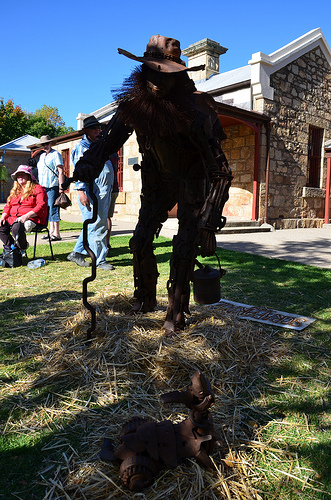
The court house in the background
Golden Horseshoes Festival
In September 1855, a long time activist for miners’ rights Daniel Cameron was elected to the state’s first legislative council, representing the Ovens electorate of which Beechworth is a part of.
Grand Parade of the 2012 Golden Horseshoes Festival
Legend has it that he rode down the main street of Beechworth in a horse shod with golden horse shoes. These were supplied by “Big” Johnston who had the biggest gold mining lease in the whole district.
The election followed a period of rivalry and clashes between two groups of miners – the “monkeys or wet diggers” who worked the creeks and wore black woollen trousers and large, coloured handkerchiefs, and the “punchers or dry diggers” who worked the dry banks and gullies and wore moleskins. The two groups fielded separate electoral candidates. “Big” Johnston belonged to the monkey faction which supported Cameron.
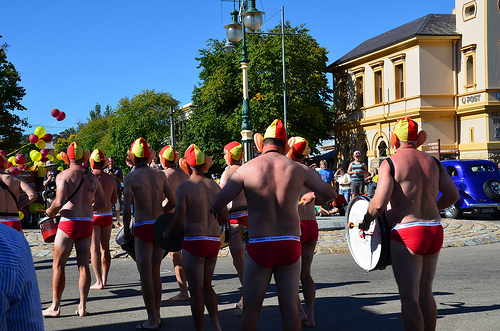
Staff from the Hibernian Hotel parading in their undies
To support their candidate on polling day, a procession of flag-waving, banner-carrying “monkeys” marched to Beechworth from their Woolshed diggings. The golden horseshoes were not fitted to the horse until the procession reached the old Vine Hotel, one mile from Beechworth, and they were removed upon arrival into town. Legend has it that they were one ounce lighter after the one mile!
Energy released by the Djembe Drum Group!
Huge crowds, free beer and brass bands added to the day’s chaos. Although the police placed a cordon across the main street at one stage, they eventually gave up trying to control the crowds. Finally, both candidates appeared at the balcony of the Star Hotel and by a show of hands (holding their miners’ rights documents), Cameron was declared elected. It is no surprise that the “punchers” demanded a recount, which was duly held at the Courthouse the following day. Cameron was again declared the elected candidate and “Big” Johnston celebrated the win with a 300-pound champagne shout.
A Circus Performance during the 2012 Golden Horseshoes Festival
These historic and turbulent political times and the associated gold legend are celebrated every year in April over the Easter weekend during the Golden Horseshoes Festival which has been held since 1873. The activities of the 2012 Festival that left the greatest impressions on me include the Grand Parade, the energetic performance by the Djembe Drum Group and the nostalgic character of the town.
Beechworth’s Town Centre
Beechworth’s commercial centre extends along Camp Street and Ford Street, presenting an almost unbroken series of elegant buildings and historic shopfronts, many dating back to the 19th century. Dominating the town’s main intersection (Ford and Camp St) is the post office built in 1869-70 to replace the original which was destroyed by fire in 1867. The present structure is an Italianate structure with a square tower containing a bell and the original clock. It features a colonnade on the ground floor and a balcony with slender columns facing Camp St. Out the front is an unusual iron drinking fountain with spouts in the shape of a lion’s head.
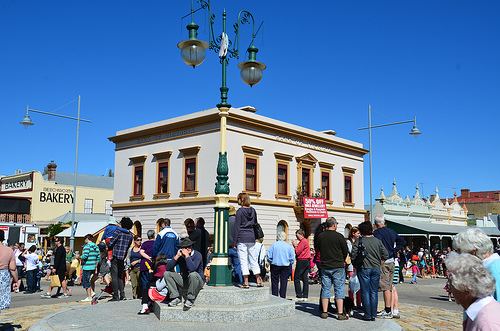
Old Bank of Victoria, corner Camp St and Ford St
The present Tanswell’s Commercial Hotel fronting Ford St was built in 1873 to replace the 1853 wooden original. It is a two-storey stone and brick structure with a decorative iron lacework verandah. The facade, with its richly gilded crest on the front window and French doors, has been carefully restored. The lounge is furnished in mid-19th century style. The Kelly gang are said to have frequented the establishment, even when there was a price on their heads. To the rear of the building are the coachhouse and stables which were built in 1859 by an American named Hiram Crawford who established his firm and a coach-building works with Tanswell’s acting as the booking office. A regular coaching service operated from Melbourne to Beechworth by 1854 but Crawford’s proved the most successful.
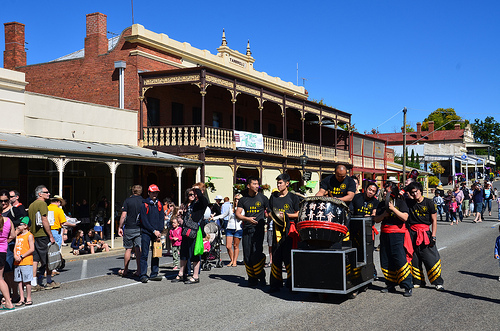
Tanswell’s Commercial Hotel, Ford St
The Historic and Cultural Precinct in Ford Street is a major attraction. It comprises the town’s old court house, telegraph station, town hall, a museum and a dark cell which at one time housed the infamous bushranger Ned Kelly.
Lake Sambell Reserve
Beechworth is known for its attractive streets and parks lined with deciduous trees which create an intense colourful display in autumn.
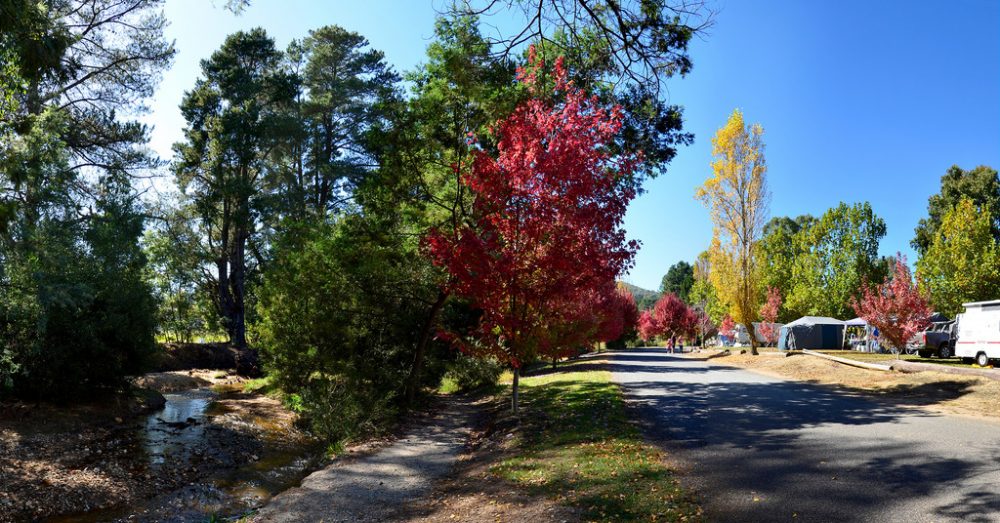
Autumn colours at Lake Sambell Caravan Park
Located just east of Beechworth’s commercial centre is the Lake Sambell Reserve. This was once a major goldmining site which yielded over 1360 kg of gold until operations ceased in 1921. The terrain was demolished by hydraulic sluicing so a dam was created to conceal the scarred landscape in 1928. Today it is a popular recreation area for boating, fishing, swimming and waterskiing. There are playground and BBQ facilities, a Bocchi court and a boat ramp on McConville Ave. The reserve includes a Chinese garden at its Albert Rd frontage, which has several ponds honouring the district’s Chinese gold rush pioneers.
Gorge Scenic Drive
The one-way Gorge Road constitutes a 5-km scenic drive around the northern and western outskirts of Beechworth. The route begins at the junction with Sydney Road where the Golden Horseshoe Monument commemorates the election of Daniel Cameronin in 1855 to the state parliament. It then runs along the edge of the Beechworth Historic Park with its network of walking trails, geological features and relics of the region’s gold mining history including a powder magazine built in 1859. Panoramic views of Beechworth and countryside to the west can be seen from a couple of large granite outcrops along the route.
The bridge where Gorge Road crosses Spring Creek offers an interesting view of the creek as it cascades downhill along a rocky bed.
Gorge Road ends at the Newtown Falls near Ford Street. A viewing platform on the left-hand side of the road provides good views of the falls and the Newtown Bridge which was constructed from granite in 1874.
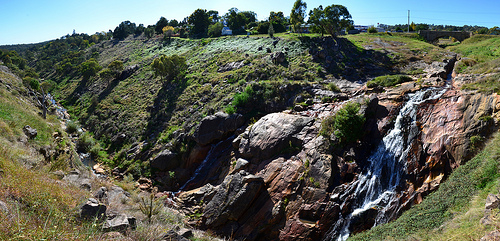
Newton Falls and Newton Bridge on the right hand side
Other Attractions and Festivals
Beechworth’s location at the foot hills of the Victorian Alps offers visitors the opportunity to explore a number of surrounding vineyards and to enjoy several scenic drives through the countryside in the area. Lookouts in the area worth visiting are the Murmungee Lookout (south of the small town of Stanley), the Mount Stanley summit (7 km southeast of Stanley) and the Mount Pilot lookout, around 15 km north of Beechworth on the road to Chiltern.
Annual events include:
- Drive Back in Time weekend which is a vintage car gathering held in February
- Beechworth Golden Horseshoes Festival in April
- Beechworth Harvest Celebration in May
- Beechworth Ned Kelly Weekend in August
- Beechworth Oktoberfest in October
- Beechworth Celtic Festival in November
The mining industry is long gone but the town has reinvented itself and evolved into a popular tourist destination and growing wine-producing centre.

